Bastien Pasdeloup
Multimodal Object Detection via Probabilistic a priori Information Integration
May 24, 2024Abstract:Multimodal object detection has shown promise in remote sensing. However, multimodal data frequently encounter the problem of low-quality, wherein the modalities lack strict cell-to-cell alignment, leading to mismatch between different modalities. In this paper, we investigate multimodal object detection where only one modality contains the target object and the others provide crucial contextual information. We propose to resolve the alignment problem by converting the contextual binary information into probability maps. We then propose an early fusion architecture that we validate with extensive experiments on the DOTA dataset.
LLM meets Vision-Language Models for Zero-Shot One-Class Classification
Apr 02, 2024Abstract:We consider the problem of zero-shot one-class visual classification. In this setting, only the label of the target class is available, and the goal is to discriminate between positive and negative query samples without requiring any validation example from the target task. We propose a two-step solution that first queries large language models for visually confusing objects and then relies on vision-language pre-trained models (e.g., CLIP) to perform classification. By adapting large-scale vision benchmarks, we demonstrate the ability of the proposed method to outperform adapted off-the-shelf alternatives in this setting. Namely, we propose a realistic benchmark where negative query samples are drawn from the same original dataset as positive ones, including a granularity-controlled version of iNaturalist, where negative samples are at a fixed distance in the taxonomy tree from the positive ones. Our work shows that it is possible to discriminate between a single category and other semantically related ones using only its label
Unsupervised Adaptive Deep Learning Method For BCI Motor Imagery Decoding
Mar 15, 2024
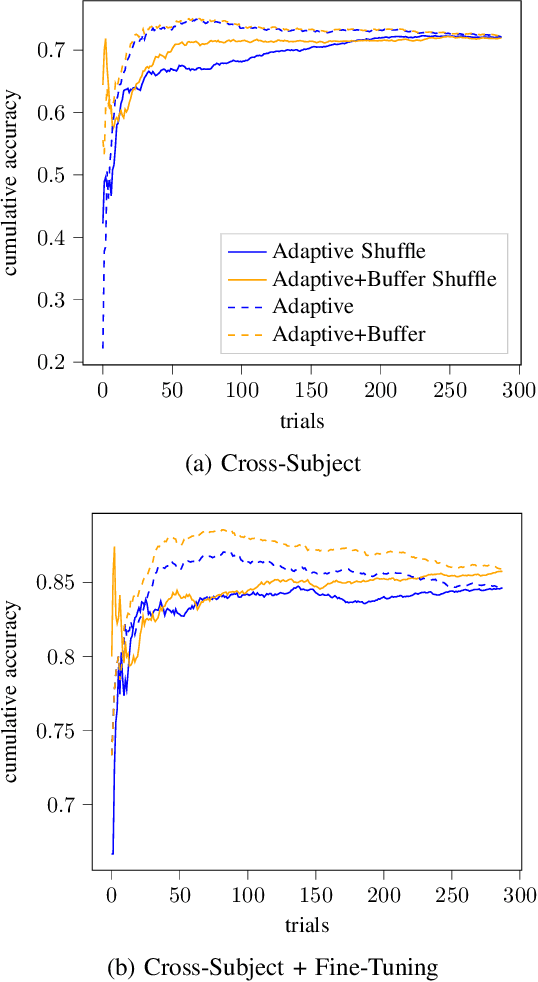
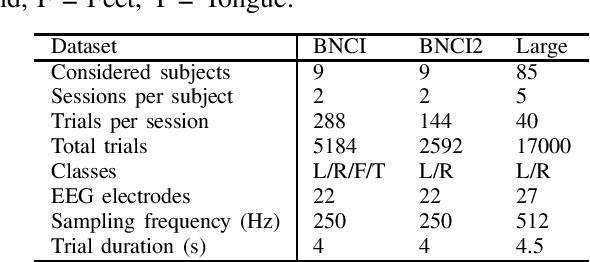
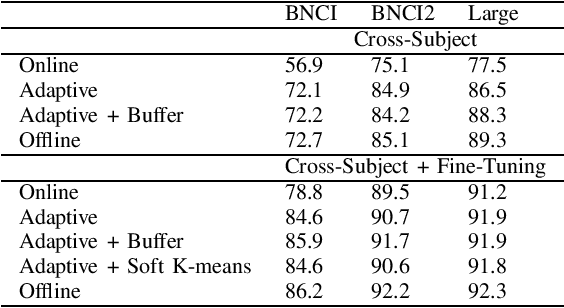
Abstract:In the context of Brain-Computer Interfaces, we propose an adaptive method that reaches offline performance level while being usable online without requiring supervision. Interestingly, our method does not require retraining the model, as it consists in using a frozen efficient deep learning backbone while continuously realigning data, both at input and latent spaces, based on streaming observations. We demonstrate its efficiency for Motor Imagery brain decoding from electroencephalography data, considering challenging cross-subject scenarios. For reproducibility, we share the code of our experiments.
Few and Fewer: Learning Better from Few Examples Using Fewer Base Classes
Jan 29, 2024Abstract:When training data is scarce, it is common to make use of a feature extractor that has been pre-trained on a large base dataset, either by fine-tuning its parameters on the ``target'' dataset or by directly adopting its representation as features for a simple classifier. Fine-tuning is ineffective for few-shot learning, since the target dataset contains only a handful of examples. However, directly adopting the features without fine-tuning relies on the base and target distributions being similar enough that these features achieve separability and generalization. This paper investigates whether better features for the target dataset can be obtained by training on fewer base classes, seeking to identify a more useful base dataset for a given task.We consider cross-domain few-shot image classification in eight different domains from Meta-Dataset and entertain multiple real-world settings (domain-informed, task-informed and uninformed) where progressively less detail is known about the target task. To our knowledge, this is the first demonstration that fine-tuning on a subset of carefully selected base classes can significantly improve few-shot learning. Our contributions are simple and intuitive methods that can be implemented in any few-shot solution. We also give insights into the conditions in which these solutions are likely to provide a boost in accuracy. We release the code to reproduce all experiments from this paper on GitHub. https://github.com/RafLaf/Few-and-Fewer.git
Inferring Latent Class Statistics from Text for Robust Visual Few-Shot Learning
Nov 24, 2023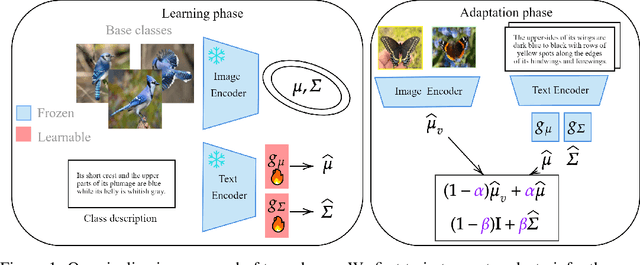

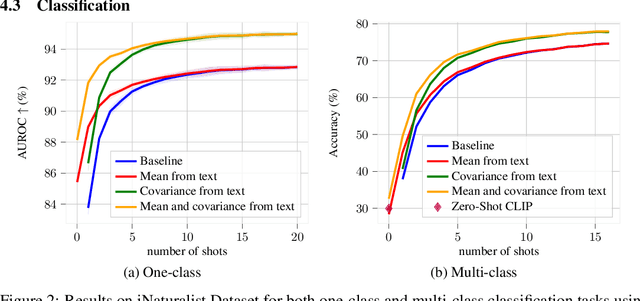

Abstract:In the realm of few-shot learning, foundation models like CLIP have proven effective but exhibit limitations in cross-domain robustness especially in few-shot settings. Recent works add text as an extra modality to enhance the performance of these models. Most of these approaches treat text as an auxiliary modality without fully exploring its potential to elucidate the underlying class visual features distribution. In this paper, we present a novel approach that leverages text-derived statistics to predict the mean and covariance of the visual feature distribution for each class. This predictive framework enriches the latent space, yielding more robust and generalizable few-shot learning models. We demonstrate the efficacy of incorporating both mean and covariance statistics in improving few-shot classification performance across various datasets. Our method shows that we can use text to predict the mean and covariance of the distribution offering promising improvements in few-shot learning scenarios.
A Strong and Simple Deep Learning Baseline for BCI MI Decoding
Sep 11, 2023
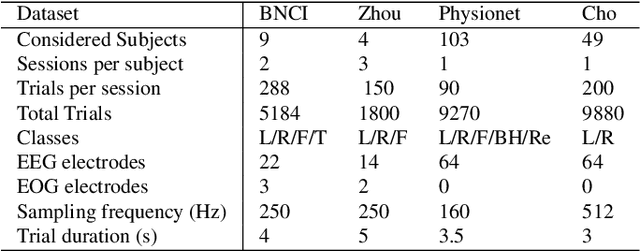


Abstract:We propose EEG-SimpleConv, a straightforward 1D convolutional neural network for Motor Imagery decoding in BCI. Our main motivation is to propose a very simple baseline to compare to, using only very standard ingredients from the literature. We evaluate its performance on four EEG Motor Imagery datasets, including simulated online setups, and compare it to recent Deep Learning and Machine Learning approaches. EEG-SimpleConv is at least as good or far more efficient than other approaches, showing strong knowledge-transfer capabilities across subjects, at the cost of a low inference time. We advocate that using off-the-shelf ingredients rather than coming with ad-hoc solutions can significantly help the adoption of Deep Learning approaches for BCI. We make the code of the models and the experiments accessible.
Disambiguation of One-Shot Visual Classification Tasks: A Simplex-Based Approach
Jan 16, 2023
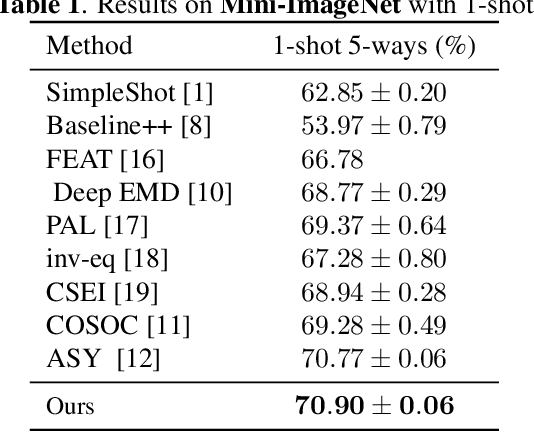
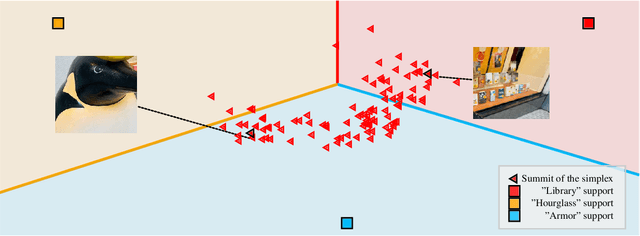

Abstract:The field of visual few-shot classification aims at transferring the state-of-the-art performance of deep learning visual systems onto tasks where only a very limited number of training samples are available. The main solution consists in training a feature extractor using a large and diverse dataset to be applied to the considered few-shot task. Thanks to the encoded priors in the feature extractors, classification tasks with as little as one example (or "shot'') for each class can be solved with high accuracy, even when the shots display individual features not representative of their classes. Yet, the problem becomes more complicated when some of the given shots display multiple objects. In this paper, we present a strategy which aims at detecting the presence of multiple and previously unseen objects in a given shot. This methodology is based on identifying the corners of a simplex in a high dimensional space. We introduce an optimization routine and showcase its ability to successfully detect multiple (previously unseen) objects in raw images. Then, we introduce a downstream classifier meant to exploit the presence of multiple objects to improve the performance of few-shot classification, in the case of extreme settings where only one shot is given for its class. Using standard benchmarks of the field, we show the ability of the proposed method to slightly, yet statistically significantly, improve accuracy in these settings.
A Statistical Model for Predicting Generalization in Few-Shot Classification
Dec 13, 2022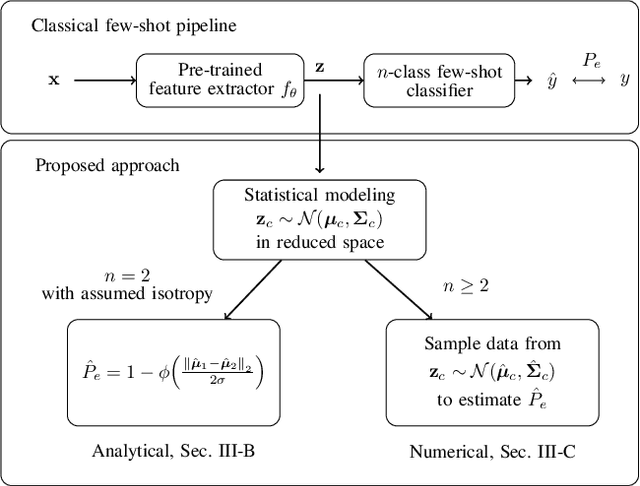
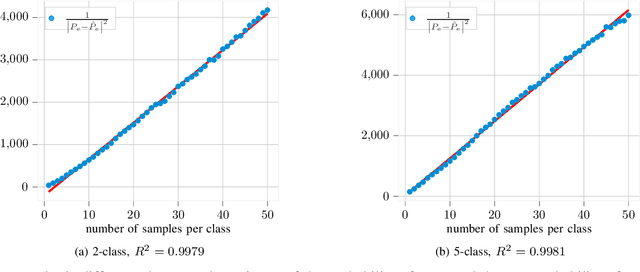


Abstract:The estimation of the generalization error of classifiers often relies on a validation set. Such a set is hardly available in few-shot learning scenarios, a highly disregarded shortcoming in the field. In these scenarios, it is common to rely on features extracted from pre-trained neural networks combined with distance-based classifiers such as nearest class mean. In this work, we introduce a Gaussian model of the feature distribution. By estimating the parameters of this model, we are able to predict the generalization error on new classification tasks with few samples. We observe that accurate distance estimates between class-conditional densities are the key to accurate estimates of the generalization performance. Therefore, we propose an unbiased estimator for these distances and integrate it in our numerical analysis. We show that our approach outperforms alternatives such as the leave-one-out cross-validation strategy in few-shot settings.
Spatial Graph Signal Interpolation with an Application for Merging BCI Datasets with Various Dimensionalities
Oct 28, 2022Abstract:BCI Motor Imagery datasets usually are small and have different electrodes setups. When training a Deep Neural Network, one may want to capitalize on all these datasets to increase the amount of data available and hence obtain good generalization results. To this end, we introduce a spatial graph signal interpolation technique, that allows to interpolate efficiently multiple electrodes. We conduct a set of experiments with five BCI Motor Imagery datasets comparing the proposed interpolation with spherical splines interpolation. We believe that this work provides novel ideas on how to leverage graphs to interpolate electrodes and on how to homogenize multiple datasets.
Pruning Graph Convolutional Networks to select meaningful graph frequencies for fMRI decoding
Mar 09, 2022
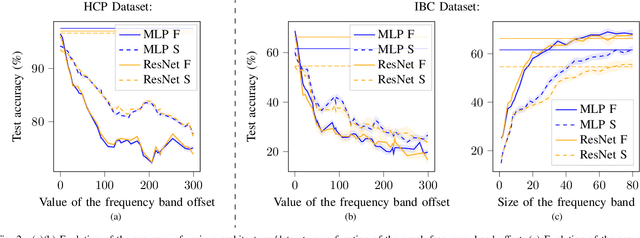
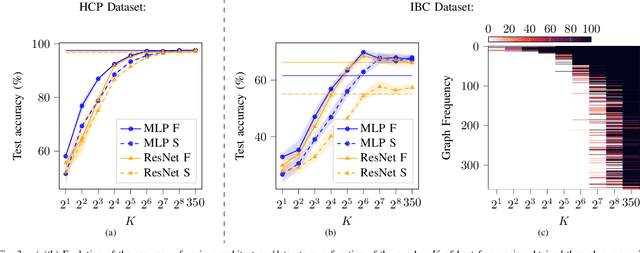
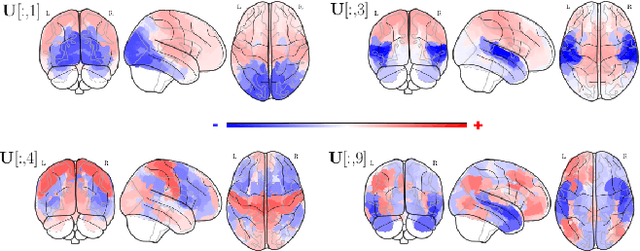
Abstract:Graph Signal Processing is a promising framework to manipulate brain signals as it allows to encompass the spatial dependencies between the activity in regions of interest in the brain. In this work, we are interested in better understanding what are the graph frequencies that are the most useful to decode fMRI signals. To this end, we introduce a deep learning architecture and adapt a pruning methodology to automatically identify such frequencies. We experiment with various datasets, architectures and graphs, and show that low graph frequencies are consistently identified as the most important for fMRI decoding, with a stronger contribution for the functional graph over the structural one. We believe that this work provides novel insights on how graph-based methods can be deployed to increase fMRI decoding accuracy and interpretability.
 Add to Chrome
Add to Chrome Add to Firefox
Add to Firefox Add to Edge
Add to Edge